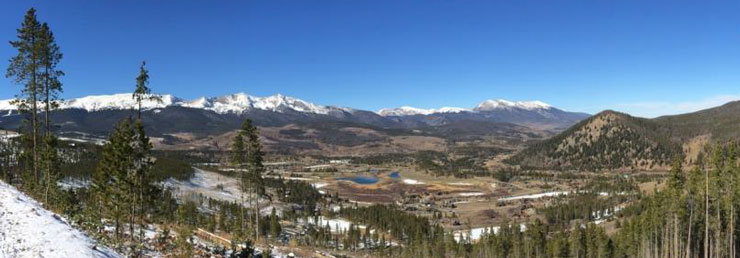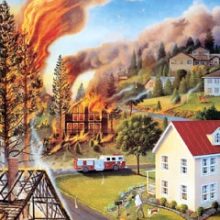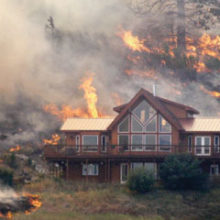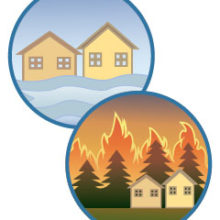- The majority of risks and costs from wildfires come from protecting homes, but there has been insufficient effort to date to modify development near wildfire-prone areas.
- A new report, using Summit County, CO, provides recommendations for how that community can improve and strengthen its approach to addressing wildfire risks.
- The lessons from this case study can help other local governments and federal policy makersdevelop best practices, lessons, and tools to reduce future wildfire risk.

Background and Goals
Wildfires pose a growing risk to many communities for several reasons: more development is occurring in wildfire-prone areas, forest management and wildfire suppression practices have produced an abundance of hazardous fuels, and a changing climate is exacerbating drought conditions and increasing the average length of the wildfire “season.”
Today, more than 72,000 communities across the U.S. are considered “communities at risk” to wildfire. Since 1990, firefighter fatalities have continued to rise, and the average number of structures burned from a wildfire has more than tripled with as many as 5,000 structures burned in recent years.
As a result, the federal government now spends an average of $3 billion per year on addressing wildfire – a figure that has tripled since the 1990s and is still typically not enough to cover the national suppression bill without shortchanging other programs.
Because the majority of wildland fire suppression costs are associated with protecting homes, this project focuses primarily on reducing the risk of home loss in the Wildland-Urban Interface.
Headwaters Economics–in collaboration with Wildfire Planning International and Clarion Associates–worked to pursue how wildfire risks to communities could be reduced through the improved application of land use policies and tools.
To this end, the three groups worked for many months with Summit County, CO to analyze and recommend changes to key planning documents and development regulations to help integrate the goals of wildfire risk reduction with land use policies and regulations – creating new opportunities to strengthen community approaches to wildfire, and defining requirements for future growth and development.
Then, using Summit County as a case study, we completed a second report with suggestions for local governments and policy officials for best practices, lessons, and tools to reduce future wildfire risk.
Lessons Learned
Land use policies and tools can provide meaningful ways for a community to strengthen its approach to addressing its wildfire risk. The recommendations in the Summit County reportapply to other communities and policy makers considering efforts to use planning and analysis to reduce wildfire risk.
Our second report provides detailed recommendations both for local communities and for federal policy makers, summarized here:
For Local Communities:
-
Is wildfire included in your Comprehensive Plan and other applicable master plans? Do a simple diagnosis to determine if and where wildfire is mentioned in key documents. Make note of areas where the term is noticeably absent. For example, the project team found that several of Summit County’s planning sections could benefit from adding wildfire references, such as in the Comprehensive Plan’s Open Space and Environment elements.
-
If wildfire is already adequately addressed in your planning policies, does this translate into your Development Code to create an enforceable set of regulations that will mitigate future risk? Summit County had excellent code language already, but the team found additional opportunities to creatively include wildfire—such as using high wildfire hazard as an additional criterion in the Transferable Development Rights program.
-
How well do your Comprehensive Plan and Development Code link to the Community Wildfire Protection Plan? The process revealed in some instances where Summit County’s plans required reconciliation and coordination between wildfire and other community topics. For example, wildfire mitigation efforts in Summit County (reduce fuels) could be at odds with the Design and Visual Resources element (hide buildings behind vegetation) unless revisions accommodate both development in forested areas and mitigation practices.
-
How user-friendly are your planning documents when it comes to wildfire? Wildfire can be a complex subject, yet communities expect and rely on residents to understand their role in mitigation. Adding illustrations, diagrams, and local resources to planning documents can help readers better understand technical requirements. Summit County was no exception, and many recommendations suggest ways to improve reader understanding through graphics or re-organized content.
Strong political support and a collaborative environment were also important success factors. The Summit County case study should give the planning profession confidence that there are many opportunities for land use planners to engage in wildfire risk reduction practices.
For Federal Policy Makers
In 2014 numerous federal agencies, including the U.S. Forest Service and Department of the Interior, finalized the National Cohesive Wildland Fire Management Strategy with three goals: restore and maintain landscapes; fire-adapted communities; and wildfire response.
The term fire adapted communities means “human populations and infrastructure can withstand a wildfire without the loss of life and property.” The National Action Plan, which is the framework for implementing the Cohesive Strategy, makes frequent mention of planning ideas such as “pursue municipal, county, and state building and zoning codes and ordinances that mitigate fire risk,” and “adapt and implement planning and zoning measures.” Yet there is little detail in these national guidance documents to explain what “planning” means.
With the Summit County case study, we hope to have answered that question: land use planning – in a wildfire context – consists of an artful mix of community-supported policies, regulations, and incentives that increase a community’s ability to withstand wildfire.
- Land use planning does not mean telling people what not to do; rather it consists of incentives intermixed with regulations and policies to reward communities to be fire-adapted.
- Assistance should be provided to communities – on a voluntary basis – in the form of grants that can be used to hire land use planning consultants with expertise in minimizing wildfire risk. Even well-staffed communities can often use extra help.
- Which rules, regulations, and incentives are applied will always be determined entirely by local elected officials and their planning departments.
- Leadership support at all levels can inspire local planning and wildfire mitigation staff to go beyond routine practices and explore innovative land use planning solutions for wildfire risk reduction.
A Possible Example of Success
Success on the ground may look something like this: A fire breaks out and is allowed to burn because of the ecological benefits. Because of a variety of risk reduction and mitigation efforts, including land use planning mechanisms, the fire burns around the community and no houses are destroyed.
Incentives for community features that reduce wildfire risk, such as fuel breaks, cluster development, landscape treatments, development and design standards, subdivision regulations and other planning tools, are successfully applied where appropriate. No expensive air tanker planes are needed, and no one is injured or killed.
As a result of good planning, wildland fire has played its role in reducing fuels, and agency funds are now used for landscape restoration projects rather than defense of homes. Developers have been rewarded, through density bonuses, expedited processing time and other incentives, for producing subdivisions that are fire-adapted. As a result of safer residential developments, home values have increased and insurance rates have declined.
Thanks to the generous support of the LOR Foundation for making this project possible, and to the Summit County Wildfire Council and the Summit County Planning Division for their time and support.
Additional wildfire risk evaluation and mitigation expertise and technical document review was provided by Kelly Johnston, RPF, FBAN (Wildland Professional Solutions) for this project.



